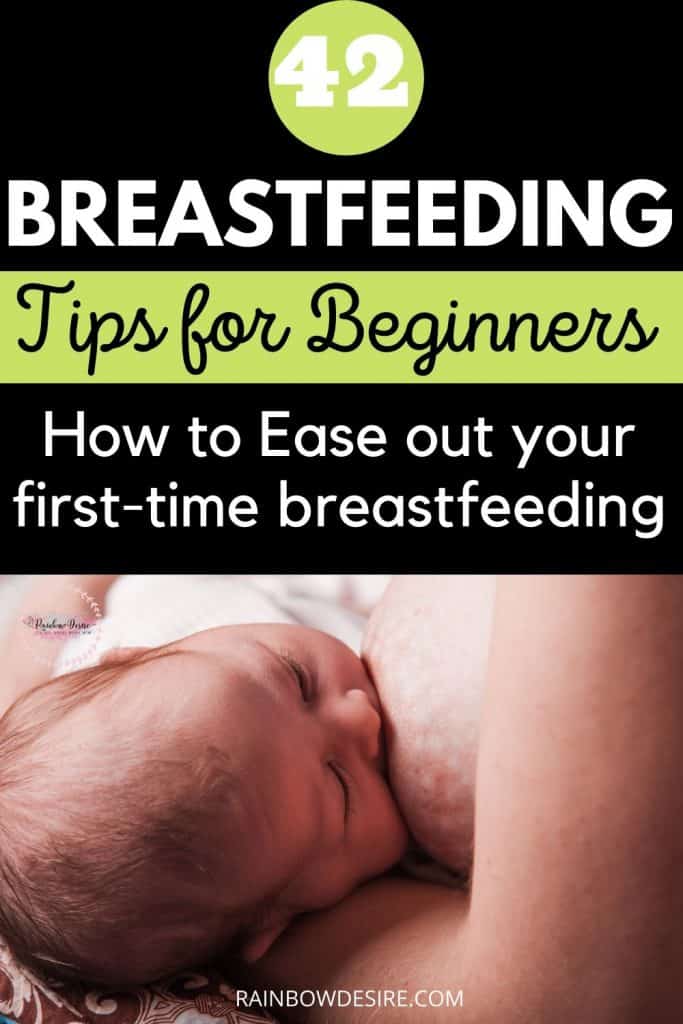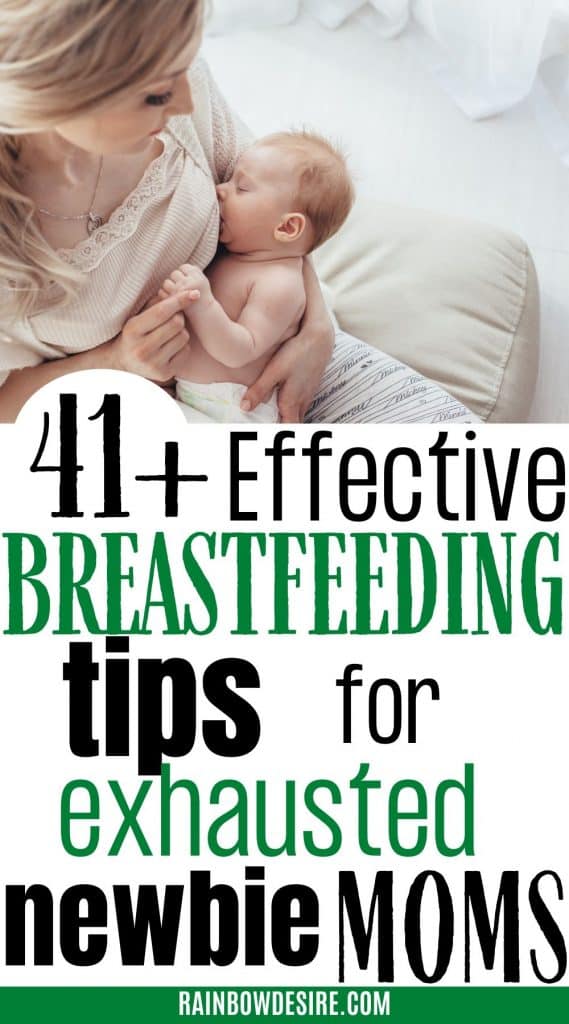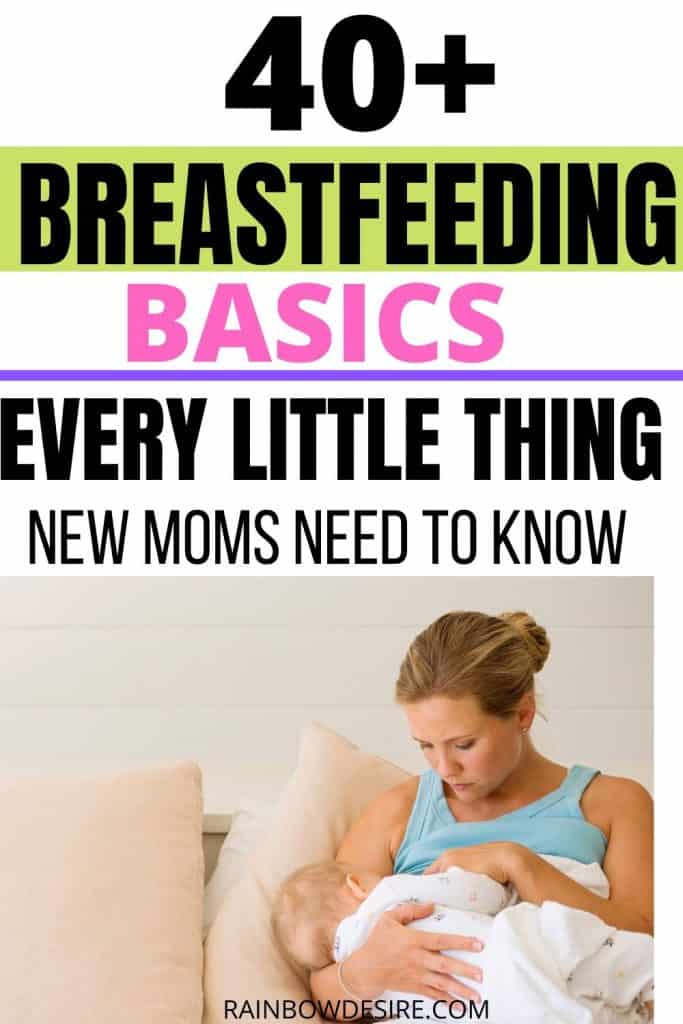We all know what breastfeeding is, but knowing and practically doing are two different things. Breastfeeding experience varies from one mom to the other.
You have to understand what breastfeeding may seem like in the first couple of weeks; it won’t stay like that. Those who are worrying about the flow should know that there have been millions of moms who were able to breastfeed successfully.
That being said, every mom has struggled with breastfeeding one way or the other.
You must have heard the slogan, “breast is best,” indeed it is, due to its natural benefits and nutritional value. Breastfeeding is getting popular as compared to a few decades ago when fewer moms chose to breastfeed, although it may get to the point that you have to struggle a bit more to get good results.
This post may contain affiliate links. Please read our disclaimer for more information.
Tips for breastfeeding moms
Although it takes several weeks for breastfeeding moms to have everything go smooth and you may have to give your baby some time to establish a good latch that will eventually lead to a picture-perfect breastfeeding experience. Remember every mom’s experience is different and so as their body.
For exclusively breastfeeding, new moms have to stay put and see how well they experience themselves as nursing moms.
For moms who choose a combination feed for their babies does not make them bad in any way. in addition to that, there are a few moms who may not have enough supply even after several weeks of trying. No matter what way you choose to feed your baby, remember, “fed is best”. You should not starve your child just for the sake of giving breast only.

1. Milk Supply takes a couple of days
Before you jump on to supplementing, remember breastmilk and the right flow takes about a couple of weeks. It is a matter of supply on demand. Your baby’s latch is essential to have the flow ready.
Babies take time to latch. Some are quick learners. They have good suckles naturally, while some have to learn and they take their sweet time.
2. Take the right advice
You may have tons and tons of advice or pressure from other moms in the family, friends, nurses, doctors, lactation consultants, listen to what they say. Some of the advice may prove to be helpful. Also, be aware you may end up having unsolicited suggestions, contradictory, confusing or just plain wrong advice.
If you want to breastfeed, someone’s advice may prove to be helpful and make things better for you. But if it is not helpful in any way, follow what you think best for your child.
If you are pregnant or a first-time mom struggling with breastfeeding, here is what you need. An online breastfeeding class by a certified lactation educator.
During this struggling period, if you think your newborn is losing weight and dehydrated due to no milk supply or less milk supply, you have to discuss it with your doctor. DO NOT STARVE YOUR BABY just out of sheer pressure of breastfeeding.
It is okay to wait for milk supply if you wish but for that, you have to remember, neither every baby is the same nor every mom, choose what is best at the right time for your baby.

3. Search for support groups
Breastfeeding could be daunting and painful in the beginning but it is not going to be the same in the coming week or months. It is going to be a beautiful motherhood experience.
However, if you still feel overwhelmed search up for support.
Get MILKOLOGY online course on Breastfeeding for a healthy start for you and your baby.
i). IBCLC
Find an international board-certified lactation consultant IBCLC. These consultants are professionals with knowledge and training in breastfeeding support. Ask your hospital or your baby’s doctor for the name of a local lactation consultant.
Visit www.ilca.org to find an IBCLC near you.
ii). Check out la leche league international
Call the national breastfeeding helpline call la Leche league or visit their website www.lalecheleague.org
iii). Get help from the hospital
Hospitals offer breastfeeding classes with lactation specialists. For first-time moms, they may want you to have a lactation class at the hospital if you are struggling with breastfeeding experience. Always ask your hospital or nurses if there is something like that.
I highly recommend first-time moms to take breastfeeding class at the hospital or take advantage of lactation expert visits while you stay at the hospital.
They are really helpful if you want to LEARN how to breastfeed.
Turn to your pediatrician for further advice or assistance.
Always talk to your baby’s pediatricians about your problems and struggles with breastfeeding and they will help you.
iv). Help from friends and family
Don’t be hesitant to enlist your spouse, partner, or friends.
Join a support group or don’t be afraid to talk to your friends and family about it. Someone’s advice or support may prove to be helpful.

4. Breastfeeding is healthiest of all feeding options
Breastfeeding is healthiest in all aspects. Not only it is nutritionally healthy food for babies, but it also reduces the risk of SIDS (sudden infant death syndrome), reduces the risk of infections, allergens, or concerning health conditions.
Breastfeeding gives moms an altogether different perspective. Your breasts are nurturing a child is an incredibly beautiful experience for moms.
Although mother feed is the healthiest food for a baby, however, it should not take a toll on your mental and physical health.
There is always room for formula feeding if you ever want to think about it. Even though a few moms get overwhelmed with the idea of breastfeeding but still most of them choose to breastfeed.
Read more about when to choose a combination feed for your baby.
5. Latch your baby right after delivery
Once you deliver, the first thing you are asked to do at the hospital is to latch your baby to the breast. Some babies learn it fast while some may take time. This totally depends on the hospital staff attitude towards breastfeeding.
It is very obvious for moms to feel emotionally and physically exhausted, which may hinder breastfeeding experience. It does not hurt to take some time in order to feel physically or emotionally ready to breastfeed.
However, the ideal situation would be to start latching or breastfeeding, right after delivery (even in the delivery room or recovery room). The sooner the better.

6. Breastfeed every 2 hours or more frequent
Sometimes nurses may take babies to the nursery room and feed a ready-made bottle so that moms can rest. If you want to breastfeed the right way, you should start while you are in the hospital at least every 2 hours to establish a good milk supply immediately after delivery.
Related: 14 natural ways to increase low milk supply for moms.
7. Getting Comfortable While Breastfeeding
When you are breastfeeding, you have to make sure you are comfortable. Either you had a vaginal delivery or a C-section delivery, you have to make sure the way you are holding a baby is not putting stress on your shoulders, belly, back, etc. Your posture should be straight and comfortable.
Have a couple of pillows for support. Keeping your essentials in an arm’s reach is helpful, a book, a phone, some snacks to munch on, a water bottle, TV remote control, etc.
While you are nursing, you have to make sure, you are not leaning on the baby rather bring your baby to the level of breasts by using support pillows or nursing pillows.

However, there are different ways you can choose to breastfeed.
i) Cradle hold
This is the most common way to breastfeed. If you had a C-section delivery you need a lot of belly support. Wearing a postpartum belly belt would give you good support. However, it may get a little uncomfortable for too many layers but it is helpful for breastfeeding as well as shrinking your body faster.
Putting pillows in the back would give your back good support to avoid any aches and pains while breastfeeding. Have a specially designed nursing pillow that would help in positioning your baby sideways.
Remember you bring baby closer to you, not lean on to get closer to the baby. Adjust baby’s height with pillows and support the baby’s head with your arm on each side while breastfeeding.
Before you try other breastfeeding positions, you should be aware of your baby has started latching.
ii) Football or clutch hold
You position your baby on one side of your arm just like a football player holding a football under his arm and runs downfield. Position baby’s head closer to your breasts so you can nurse with convenience.
iii) Side by side are lying down position
Once you get comfortable breastfeeding and get your flow just in time, you can breastfeed in a laying down position. You can do this if you feel exhausted or just due to c-section delivery.
8. Make sure there is enough Breathing room for baby
Regardless of what breastfeeding position you choose, you have to make sure you and your baby are comfortable. Your baby needs support under her head. But you still need to make sure there is plenty of room for her to adjust while she is close to your breast.
There should be enough room to breathe at all times. As a general rule, at least one nostril is visible at all times and not completely covered by your breast.

Read more:
22 things new moms should know about newborns.
9. Make the best use of Colostrum
It is the first natural food for your baby, thick and yellowish milk your breast starts producing earlier in the second trimester. Colostrum provides them everything they need for the first several days of life including nutrition and infection-fighting antibodies.
By the end of the first week, if not sooner, you most likely be able to produce runny flow milk called transitional milk.
However, if you are already producing colostrum, you are almost halfway there.
10. Ensure a Proper Latch
When your baby latches, you have to make sure, it has the whole areola in her mouth (the darker part) as she sucks.
To nurse effectively, babies tend to use their tongues to essentially lap or massage milk out of the breasts.
However, sucking with no outcome is going to be painful for a while and after that, it is smooth sailing.
Read this on how to deal with breastfeeding problems for the first few weeks.

11. Develop baby’s interest in nursing
You have to develop your baby’s interest in breastmilk by gently expressing a few drops to have her coming for the target.
Rooting reflex is a reflex that should have a baby open her mouth in search of mom’s nipple.
Try to lightly stroke her cheeks just to the sides on her mouth to stimulate rooting reflex. You should help her open her mouth wide.
If baby’s suckle is bothering you because of the wrong latch, gently insert your finger in baby mouth and pull a breast out with the help of your finger. Do not just pull off as it is going to hurt more.
Do not hesitate to try again if the baby refused to nurse for the first time.
Related: How to deal with Breastfeeding problems.
12. Dealing with tongue-tie
You have to make sure if your breastfeeding experience is not working with all the struggle, there are chances your baby is tongue-tied.
Tongue-tie is caused when a piece of tissue under the tongue limits the ability of the tongue to extend known as ankyloglossia. The vast majority of babies have been able to successfully breastfeed with no issues. However, for some in order for them to breastfeed, they need a minor procedure to help them latch.
15 newborn health conditions new moms should get an immediate evaluation.
13. When breastfeeding becomes painful
Not every breast or nipple is created equal. There are different sizes and shapes. Sometimes nipple size may become a problem for breastfeeding. In order to solve that, moms may use a nipple shield for a better breastfeeding experience.
Breastfeeding becomes painful with sore nipples, cracked and dry nipples that hurt. Once you have the flow and your baby gets a proper latch then the pain surely fades away.
Mild irritation or discomfort that occurs only at the start of each feeding is generally associated with the newness of breastfeeding. Use alternate breasts to get used to the new journey of nursing.
Once mother feed starts coming in, you have to make sure the baby is latching properly and the pain will go away. Using nipple cream after every feed is highly recommended.

Learn the Best solutions to deal with breastfeeding discomforts.
14. Timeline for milk supply you should keep in mind
It takes about 2 to 5 days for milk to settle in from colostrum to transitional milk, and then mature milk.
Although for some moms it is a few hours of colostrum and then good enough milk to have a sufficient flow of transitional milk. Mom and baby both get hang of breastfeeding smoothly.
- There could be a number of factors in delayed milk production, most common in C-section moms.
- The effect of IVs for C-sections mom.
- The effect of a medicine.
Related: Food that helps increase milk supply faster.
15. How much milk supply is enough in the beginning
However, for a few new moms, it is not as easy as it may sound. The noticeable change in milk takes place over the course of a few days. If you are concerned about your milk flow, or if your newborn baby is getting enough, or there are signs when you are not sure what is going on.
For instance, you may notice a perfect latch but no supply or your baby is crying unusually too much possible due to hunger or, not having enough wet diapers, then you should never delay a visit to a pediatrician.
Not every case is the same. You should never delay if you feel your baby is not getting enough.
When milk production progress, you would know when yellowish milk becomes white, appears thinner and clearer.
The baby would be making more obvious and gulping noises, and they may seem more calm and busy
Every mom would have that tingling sensation, although not the same for everyone when milk production increases and breasts become more fuller.
Related: 14 proven ways to improve low milk supply overnight.

16. Ways you can deal with breast engorgement
When milk production starts, fullness from breastmilk often called engorgement. It means full to the capacity of being painful.
Frequently nursing your baby can help with breast engorgement as fuller breasts can be painful and the letdown tingle can be seriously uncomfortable for new moms.
- Using a Breast pump can be helpful if the let-down is pretty quick.
2. Express some of the milk to relieve the pain. And expression to the extent that your body gets the message of producing more.
3. Taking a warm shower and using a warm compress on your breast can be a source of relief.
17. Dealing with Mastitis
Mastitis is a breast infection when one of the milk ducts gets infected that stores milk. This will cause swollen, red, painful breasts. In a couple of days, you start feeling sick, feverish, very achy in your breast.
You need to start antibiotics once it is evaluated by the professional health provider.
In the meantime, you can still breastfeed as frequent as every two hours to keep the breasts becoming overly sore
Make sure your baby is latched on well every time you breastfeed and try to change the positions.
- Apply a warm compress
- Wear a well-supported bra and massaging the breasts may speed up the healing process.

18. Dealing with Leaking breasts
Not every mom has the same amount of leaking breast issues.
Leakage will subside with time. You may experience more leakage with your first child doesn’t mean it is going to be the same as the second one too. This process will take its own time of recovery. Do not stress over it.
Another way you can stop leaking is by putting inward pressure on your breasts. Pushing back your breasts with closed arms if you are in public, may work most of the time.
Using breast pads and keep a few in your baby bag if you have leaky breasts most of the time, would help with public exposure of wet shirts.
19. Use nursing bra for the better breastfeeding experience
A good nursing bra, a sports bra is going to be super helpful for your whole breastfeeding experience. It is not only going to protect your breast from sagging but also keep them in a good shape.
- You need a good fitting bra, not too tight and try to wear it 24/7.
- Prefer comfort and convenience when choosing a bra that you are going to wear 24 hours a day.
- It should be easy to use and has flaps to fasten and unfasten.
- There is room for expansion as when the breasts are fuller, they should not be bulging out.
20. Feeding frequency
The aim is to give 8 to 12 feedings to your newborn baby during 24 hours.
For newborns, you need to feed more frequently every 2 to 3 hours once your milk supply settles in.
During the day, keep it more frequent feedings for a better and faster flow. However, for the night, if your newborn sleeps for at the most 4 hours and eats well during the day then you can stretch your night feedings for upto 4 hours. Set your alarm to feed your baby.
Most likely babies wake up within 3 to 4 hours at night to breastfeed.
If you are struggling with your milk flow and your baby is not eating well during the day or does not have enough wet diapers, then you should wake up every two hours to establish a good flow to breastfeed.
When you are trying to establish a breastfeeding routine for your newborn, you should breast every 2 to 3 hours, keeping one stretch for 4 hours or more preferably at night for a better routine.

21. Breastfeeding on the go
One of the advantages of breastfeeding is you can nurse whenever your baby needs to eat. Either you are traveling by car or in an airplane, visiting a friend or going to the mall, you have all the ease and convenience of feeding your baby without having to worry about bottles.
22. Breastfeeding in public
Many moms, if not all, are comfortable breastfeeding in public and there is nothing wrong about it. It is all about when and what your baby needs and how comfortable you are to breastfeed in public.
Using a nursing cover while in public is the best you can do for having some privacy.
23. Breastfeeding by number
Breastfeeding every 2 to 3 hours means, if you are feeding at 8 AM in the morning, that may last till 8:30 with a consequent diaper change, then the next feed is going to be at 10:30.
If the nursing session lasts from 8 AM till 9 am on each breast, then the next feeding will be at 11 am.
24. How frequent mom should nurse
Moms need to feed 8 to 12 feedings in 24 hours a day to make sure your newborn is not dehydrated and gaining weight.
25. Consider Signs of inadequate Milk supply
Newborns who are still waiting for mother’s milk to come in or those who are slow to latch on, or nurse even when there is abundant milk supply would end up having less energy and tend to sleep more.
When newborns seem less interested in feeding become lethargic, sleepy, dehydrated and more fatigued.
In the beginning, new moms have to work hard to have them eat every 2 to 3 hours during the day to establish routine and healthy weight gain.
Related: 14 tried and tested tips to improve low milk production.
Read about
How you can improve milk supply with a healthy diet.
New mom’s mistakes with newborns.
26. When your baby is on Breastfeeding strikes
If your newborn does not seem interested in eating or skipping meals, or has difficulty feeding then you should not delay your doctor’s visit.
15 health conditions that need immediate medical evaluation.

27. Things you should know about Baby’s weight
This is a really important measure after birth. Although all newborns are expected to lose weight after birth but not more than 7 to 10% of their birth weight. Your pediatrician in 3 to 5 days appointment can tell you if your baby is losing more weight. On your baby’s 2 weeks checkup, if she is gaining back her birth weight then it is a sign the breastfeeding experience is going great.
However, if your baby is losing weight then it is a matter of concern and you should not delay a visit or call doctor’s office without waiting for a 2-week checkup.
28. Alternate breasts to nurse
Nursing on both sides every time is going to be helpful for good flow on both sides as well as avoid engorgement on one breast.
Ideally, 15-minutes of breastfeeding on each side is going to prevent any lopsidedness in your breasts.
29. Hindmilk – benefit of emptying breasts
Some experts believed that fully nursing on one side would give babies a dessert equivalent of hindmilk that is richer in fats and more creamy than foremilk that babies need to grow and develop.
If you notice, your baby has green frothy poops, this could be a sign your baby is not getting enough hindmilk.
Emptying one breast in each feeding would help your baby benefit from hindmilk.
Keep track of what side you have nursed previously and then start off with the other side if you are choosing one side for each feeding.
Use breastfeeding reminder bands so that you do not forget which side you nursed last.
30. Do not worry about newborns bad habits
There is no such thing as spoiling your newborn babies for the first several weeks. If your baby demands feed or seem hungry, nurse if needed. You should always be available to your newborn needs in order to make sure they are well fed.
31. Avoid Using Pacifier for the first few weeks
Newborns tend to suck on as their natural instinct. For some babies, sucking is not just about getting fed. This interest is known as non-nutritive sucking and this is the reason why pacifiers come in handy to console the fussy baby.
Using a pacifier may calm babies when they just want to suck on fingers or breasts with no urge to eat.

You can use a pacifier to help baby sleep at night.
32. When you should start using a bottle to feed
If you want to introduce a bottle whether formula or breastmilk in a bottle you should wait at least 4 to 6 weeks until you have a good milk supply to pump. Babies find artificial nipples more convenient and effortless than to lap out milk out of breasts.
So if you want to introduce a bottle, wait for a few weeks. Let your baby get regular on latching, nursing, peeing, pooping and gaining weight then you can start on pacifier or bottle feeding.
Anxious to breastfeed? when to choose a combination feed for your baby.
33. Facts about pumping breastmilk
For irregular pumping, you can use a manual pump. Whereas for a routine and scheduled pumping, using an electric pump is a great option.
Besides, what type of pump you end up getting, Haakaa manual pump is something you need anyway. This will help moms save gold milk during sudden leaks and preserve it with a lid. Also, it can significantly help with breast engorgement which is painful.
Most likely if you have insurance, you may get on free from your insurance depending on the perks you have.
If you are pumping then there are chances your body is producing more milk. You can pump and store in the freezer in milk storing bags.
34. Keeping milk outside or frozen
Breastmilk is good for 6 to 8 hours at room temperature if it is very clean but no more than 3 to 4 hours is the best.
Refrigerated breastmilk is good if used within 3 days. It is still okay if used within 3 to 5 days.
Breastmilk can be frozen and used for up to 12 months on 0-degree Fahrenheit or colder. Otherwise 6 months on 24 degrees Fahrenheit or less.
Once you thaw frozen breastmilk you should never freeze again.
Writing dates on the milk storing bags is a great way to avoid any expired milk consumption. However, as a general rule of thumb if breastmilk smells bad it is better to dispose of.

35. Breastfeeding moms eating habits
Breastfeeding doesn’t take more than 500 calories a day. Moms do not have to go wild over their cravings. However, you still have the right to eat for two. Drink plenty of water and avoid extra sugars to stay in shape and lose weight while you are breastfeeding.
Babies can handle pretty much everything you eat, however, you still want to avoid some gassy foods for several weeks when your baby’s digestive system is developing. Although this is not supported by research, yet a lot of moms swear by some foods that they ate made their babies gassy.
Whenever you breastfeed keep a water bottle with you to stay hydrated. You can have flavored water or just plain water as per your taste. Staying hydrated can definitely help things get flowing.
Read more
Food that helps moms improve milk supply for breastfeeding moms.
36. Medication for Breastfeeding moms
Whether you are taking supplements, herbal medication, prescription or pain medication, you should always talk to your doctor about it, regardless. Medications may have a negative effect on the milk supply.
Some medication is safe to use in breastfeeding as it does not have any effect on breastfeeding babies.
Studies reveal that intake of Caffeine – i.e. 2 to 3 cups of coffee (200 to 300 mg of caffeine) per day poses no inherent harm to nursing mothers and babies.
That being said, if you still notice your baby is irritable or fussy, you might want to try decreasing or gradually eliminating your caffeine intake.
37. Impact of Smoking and alcohol on breastmilk
Smoking cigarettes pose some health issues for your newborn. It may increase the risk of asthma, and SIDS.
For those moms, who still smoke, the AAP recommends only doing so right after nursing, smoking no more than a few cigarettes, and never smoking around your baby in your house or car.
Consumption of alcohol may significantly impair mothers’ ability to care for their newborns. However, knowing all those side effects of alcohol, AAP recommends having an occasional drink of alcohol right after nursing. Wait for 2 hours for the alcohol content to drop in breastmilk before starting the next feed.
Marijuana has the ability to reach fetuses during pregnancy and as well as potentially affect breastfed infants.

38. Bottles and nipples care for pumping
For newborns, the 4-ounce bottle is a perfect choice. When baby gets bigger you can start using 6 to 8 ounces bottles.
When you choose a bigger bottle make sure you also buy nipples for 3 months and 6 months as required to have better flow and better feeding experience.
Angled bottles and those with disposable bags, built-in vents or flow, may help in swallowing less air while feeding. An added benefit of milk storing bags is, you need to wash only nipples in the end.
39. Safety measure on Heating Breastmilk
Do not use the microwave for heating breastmilk, However, bottle warmers are the best option to warm breastmilk.
40. How to clean up bottles
Although all ready-to-feed bottles come with packages nipples that are safe to use, however it is still recommended to sterilize all feeding supplies and pacifiers before using.
You can buy a sterilizer available in the market or else you can sterilize your supplies by putting them in boiling water for about 5 minutes.
Washing bottles after every feeding is also practiced by many parents and that also kills most of the germs.
Invest in bottle and nipple brushes that are inexpensive and invaluable for cleaning hard-to-reach places.
You can buy a dishwasher safe basket to hold all your small feeding supplies to wash in a dishwasher.
41. Take Growth spurts into consideration
When babies grow their needs, and eating requirements grow too. That means increased hunger as your baby keeps growing. So moms need to incorporate variability in baby’s everyday routine.

42. Feed on demand or Cluster feeding
When you choose to feed on demand is called cluster feeding. If a baby decided to eat several times of the day when you are not following a 2 to 3 hours timeline.
Remember, babies who eat well during the day may end up sleeping at stretch at night.
Read more
13 Baby’s sleep mistakes you should not make from the very beginning.
43. Use vitamin D drops while breastfeeding
Vitamin D is an important nutrient that helps prevent rickets and strengthens the immune system and reduce the risk of diabetes and other chronic diseases.
Chances are your pediatrician is going to provide you with vitamin D drops on your baby’s first checkup. You may have to apply a few drops on your nipple so the baby can easily suck on while feeding.
Breastfed babies need vitamin D drops whereas among formula-fed babies require only those who do not drink at least 32 ounces of formula every day.
44. Choosing pacifier
You can choose to use a pacifier for your baby if she is super fussy and sucking on fingers even after getting a good number of feedings.
Be sure not to offer pacifier when your baby needs to be fed and hungry.
Babies seem disinterested in pacifiers when they do not see anything coming out of it. Keep trying if you feel your baby is still in search of breast just for comforts not because of hunger.
45. when babies get gas due to mother feed
Breastfed babies tend to get gassy due to specific types of food moms eat. Although this argument is not supported by science still many moms notice babies being fussier when they eat certain types of food. Not every mom face this, like I said, every mom and baby is different.
What food new moms should eat during postpartum.
This does not mean you should avoid eating gassy foods altogether, however, the best approach is to avoid gassy foods for about 4 to 6 weeks after delivery until the baby’s digestive system gets mature enough to handle gas.
Read more
How to relieve gas issues in babies.
How to soothe colic or a fussy baby.
These are the breastfeeding suggestions for new moms. Let me know in the comments if you have something to share.








